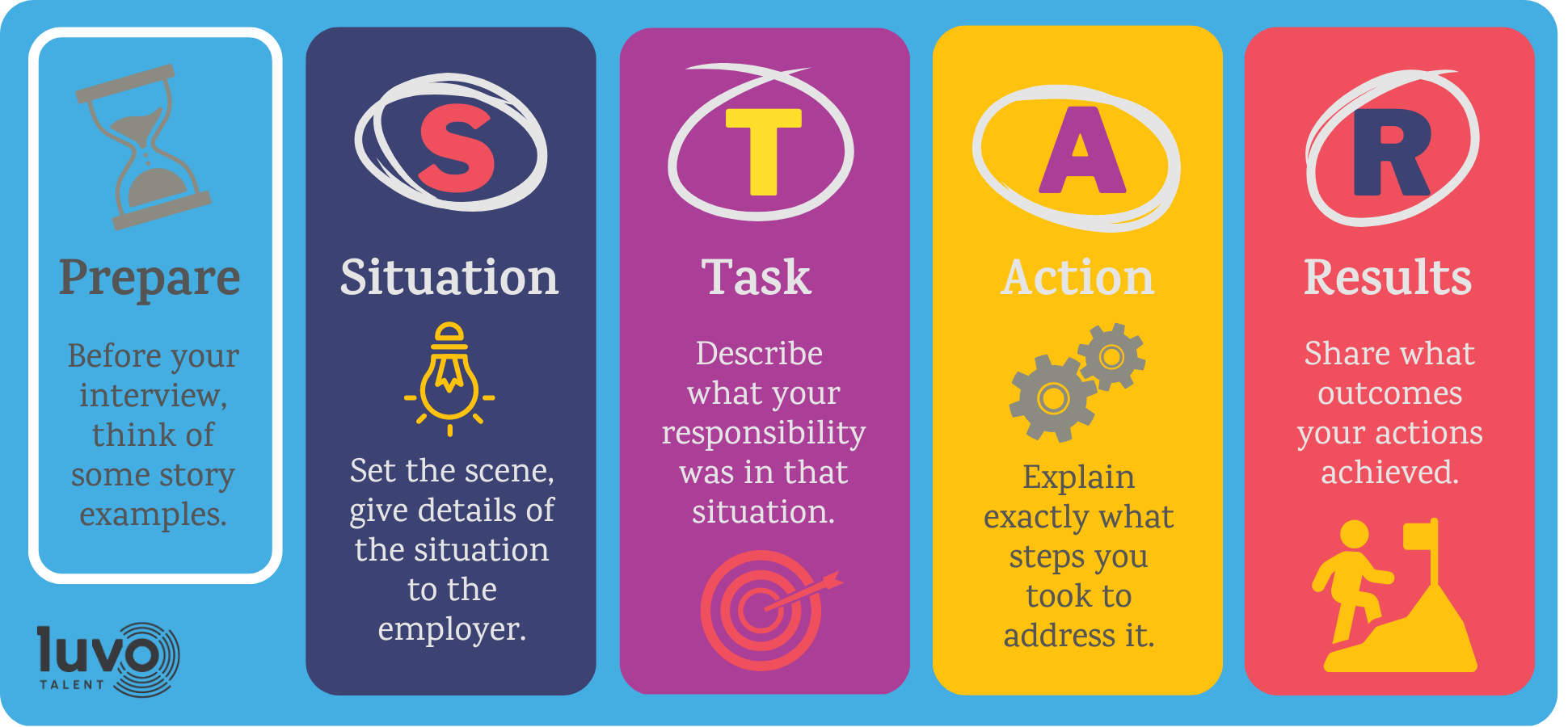
Are you good at remembering information when put on the spot? Or do you sometimes forget to mention some key detail?
It’s normal to sometimes feel a bit stressed during job interviews. We’ve all been there.
Thinking of examples to questions on the spot can be tough when the pressure is on to deliver a clear message.
We recommend using the STAR interview method. This strategy allows you to come up with impressive answers from your own experience to the typical types of interview questions that arise.
What is the STAR method?
The STAR method is a structured way of answering behavioural interview questions. It stands for Situation, Task, Action, and Result – it allows you to tell a structured story.
Situation: describe the context in which you faced a challenge or opportunity
Task: explain the goal you were trying to achieve
Action: describe the specific steps you took to address the situation
Result: discuss the outcome of your actions and what you learned from the experience.
The STAR method helps you provide specific and detailed examples of your experiences. It allows you to demonstrate your skills and abilities, making it easier for interviewers to evaluate and digest your narrative.
The STAR method infographic
Which questions can the STAR method be used for?
The STAR method is particularly useful when asked for specific examples of past experiences. Here are some common questions you might get in an interview where you can apply this simple strategy:
- How do you handle pressure at work?
- Tell me about your proudest professional accomplishment.
- Describe a time you failed and how you dealt with it.
- Tell me about a time when you went above and beyond.
- Describe a project you led and the steps to ensure its success.
- Tell me about a situation where you had to work with a team to achieve a common goal.
- Which tools or techniques do you use to draw out requirements when they are not sufficiently distinguished?
- How do you manage situations when the scope, strategy, or roadmaps are not obvious?
By using the STAR method, you can provide a comprehensive answer that showcases your abilities and experiences, demonstrating to the interviewer how you can handle similar situations in the future.
How do you use the STAR method?
Here are a few examples of situations you could use when answering behavioural interview questions using the STAR method.
Leading a team project:
Situation: You were a project manager on a team responsible for delivering a new product launch.
Task: Your goal was to ensure that the project was completed on time, within budget, and to the required quality standards.
Action: You held regular team meetings, delegated tasks effectively, and provided clear communication and guidance to team members. You also worked with the project sponsor to resolve any issues that arose during the project.
Result: The product launch was successful, with all objectives met or exceeded. The project was delivered on time and within budget and received positive feedback from both stakeholders and end-users.
Improving process efficiency:
Situation: You were working as a process engineer and identified an opportunity to streamline a production process.
Task: Your goal was to improve the efficiency of the process and reduce costs.
Action: You conducted a thorough analysis of the process and identified bottlenecks and inefficiencies. You then worked with cross-functional teams to implement changes, such as automating manual tasks and streamlining processes.
Result: The changes you made resulted in a 20% reduction in production time and a 15% decrease in costs, leading to improved profitability for the company.
Solving a complex problem:
Situation: You were working on a technical project and faced a complex problem that needed to be resolved.
Task: Your goal was to find a solution to the problem and complete the project.
Action: You gathered and analysed data, consulted with subject matter experts, and used your technical knowledge and experience to generate multiple solutions. You then worked with stakeholders to determine the best solution and implement it.
Result: The problem was resolved, and the project was completed successfully, meeting all objectives and deadlines. Your solution was praised by stakeholders and considered best practice within the organisation.
How to prepare to use the STAR method ahead of your interview
To be ready to use the STAR method in your next interview, it’s helpful to prepare what stories or examples you might tell and how you will tell them. Here are some tips:
- Review the job description for the role you are applying for.
- Choose a few strong, versatile example stories from your experience.
- Write down key details so they are easier to recall later.
- Practice your storytelling on supporters such as friends and family.
- Don’t rush through it, take your time to get your point across clearly.
The STAR interview method might seem a little overwhelming at first, but with a little preparation, you’ll soon view behavioural interview questions as less stressful and more as an opportunity to communicate your awesomeness!
For more information
To see which IT roles we are currently recruiting for, send us your CV or check out our Job Board for current openings. Whether you’re looking to join a dynamic start-up or a large enterprise, our Talent team is committed to finding you a new role at a company that’s right for you.



